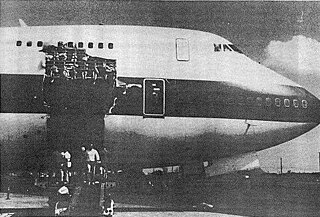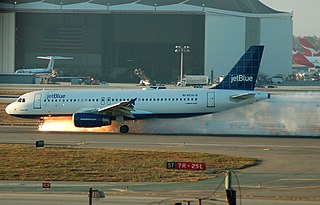SAM was a Colombian airline. With its main hub at El Dorado International Airport in Bogotá, SAM operated domestic and international routes and was a subsidiary of Avianca. In 2004, its headquarters were in the Avianca headquarters in Bogotá.
Kalitta Air is an American cargo airline headquartered at Willow Run Airport, Ypsilanti Township, Michigan. The company operates international scheduled and cargo charter services. Its call sign "Connie" is from its founder, Connie Kalitta.
This is a list of aviation-related events from 1989.

El Dorado International Airport is an international airport serving Bogotá, Colombia, and its surrounding areas. The airport is located mostly in the Fontibón district of Bogotá, although it partially extends into the Engativá district and through the municipality of Funza in the Western Savanna Province of the Cundinamarca Department. It served over 36 million passengers in 2022 making it the busiest airport in South America and 2nd overall in Latin America in terms of passenger traffic. As well as being the 32nd busiest airport in the world. With 760,000 metric tons of cargo passing thorugh the same year it is also Latin America's most important cargo hub. El Dorado is also by far the busiest and most important airport in Colombia, accounting for just under half (49%) of the country's air traffic. The facility covers 1,700 acres (6.9km2) and contains two 3,800m long runways.

Delta Air Lines Flight 1141 was a scheduled domestic passenger flight between Dallas/Fort Worth, Texas and Salt Lake City, Utah. On August 31, 1988, the flight, using a Boeing 727-200 series aircraft, crashed during takeoff, resulting in 14 deaths and 76 injuries of the 108 on board.

United Airlines Flight 811 was a regularly scheduled airline flight from Los Angeles to Sydney, with intermediate stops at Honolulu and Auckland. On February 24, 1989, the Boeing 747-122 serving the flight experienced a cargo-door failure in flight shortly after leaving Honolulu. The resulting explosive decompression blew out several rows of seats, killing nine passengers. The aircraft returned to Honolulu and landed with no further incident.

An emergency landing or crash landing is a premature landing made by an aircraft in response to an emergency involving an imminent or ongoing threat to the safety and operation of the aircraft, or involving a sudden need for a passenger or crew on board to terminate the flight. It typically involves a forced diversion to the nearest or most suitable airport or airbase, or an off airport landing or ditching if the flight cannot reach an airfield. Flights under air traffic control will be given priority over all other aircraft operations upon the declaration of the emergency.
Aerosucre S.A. is a cargo airline based in Bogotá, Colombia. It began operation in 1969 and operates scheduled international and domestic cargo services throughout Latin America and the Caribbean. Its home base is El Dorado International Airport, Bogotá. Aerosucre has been involved in a number of accidents and incidents during its lifetime, and more recently, internet videos have emerged showcasing reckless behavior by its pilots.
The article describes accidents and incidents on Korean Air and its predecessor companies Korean National Airlines and KAL.

As of July 2020, a total of 60 Boeing 747 aircraft, or just under 4% of the total number of 747s built, first flown commercially in 1970, have been involved in accidents and incidents resulting in a hull loss, meaning that the aircraft was either destroyed or damaged beyond economical repair. Of the 60 Boeing 747 aircraft losses, 32 resulted in no loss of life; in one, a hostage was murdered; and in one, a terrorist died. Some of the aircraft that were declared damaged beyond economical repair were older 747s that sustained relatively minor damage. Had these planes been newer, repairing them might have been economically viable, although with the 747's increasing obsolescence, this is becoming less common. Some 747s have been involved in accidents resulting in the highest death toll of any civil aviation accident, the highest death toll of any single airplane accident, and the highest death toll of a midair collision. As with most airliner accidents, the root of cause(s) in these incidents involved a confluence of multiple factors that rarely could be ascribed to flaws with the 747's design or its flying characteristics.

China Airlines Flight 605 (CI605/CAL605) was a daily non-stop flight departing from Taipei at 6:30 a.m. and arriving at Kai Tak Airport in Hong Kong at 7:00 a.m. local time. On November 4, 1993, the plane went off the runway and overran while landing during a storm. It was the first hull loss of a Boeing 747-400.

On 4 October 1992, El Al Flight 1862, a Boeing 747 cargo aircraft of the Israeli airline El Al, crashed into the Groeneveen and Klein-Kruitberg flats in the Bijlmermeer neighbourhood of Amsterdam, the Netherlands. The crash is known in Dutch as the Bijlmerramp.

MK Airlines Flight 1602 was an MK Airlines Boeing 747-200F cargo flight on a flight from Halifax Stanfield International Airport, Nova Scotia, Canada to Zaragoza Airport, Spain. It crashed on take-off in 2004, killing the crew of 7. It was the fourth accident for MK Airlines, as well as the deadliest.
In aeronautics, loss of control (LOC) is the unintended departure of an aircraft from controlled flight and is a significant factor in several aviation accidents worldwide. In 2015 it was the leading cause of general aviation accidents. Loss of control may be the result of mechanical failure, external disturbances, aircraft upset conditions, or inappropriate crew actions or responses.

Olympic Airways Flight 411 was a flight from Ellinikon International Airport bound for John F. Kennedy International Airport and operated by Olympic Airways using a Boeing 747-200. On August 9, 1978, the flight came close to crashing in downtown Athens. Despite maneuvers near the edge of the flight envelope, none of the 418 passengers and crew suffered serious injury.

Kalitta Air Flight 207 (K4207/CKS207) was a scheduled cargo flight between John F. Kennedy Airport to Bahrain International Airport with a technical stopover at Brussels. On May 25, 2008, the Boeing 747-200 overran runway 20 during takeoff at Brussels Airport, causing the aircraft to split into three large pieces. The occupants sustained minor injuries.










